Prime Graphs with Almost True Twin Vertices
Abstract
1. Introduction
2. Presentation of Results
- (A1)
- X is a clique in G, and is the unique neighbor of x in S, for each vertex x in X.
- (A2)
- The two vertex subsets X and are complete to each other, while X and are anti-complete to each other.
- (A3)
- For each dominating vertex t of the subgraph , .
- (a)
- Consider the graph G illustrated in Figure 2. Let , , , and , and consider the subgraph . Thus , . Let be the surjection from to defined by and . The triple satisfies assertions and but does not satisfy Assertion (because d is a dominating vertex in , and , and hence is a singleton of ). Now, consider the vertex subsets , , , and , and consider the subgraph . Thus , . Let be the surjection from to defined by and . The triple satisfies assertions , , and . Notice that and .
- (b)
- Consider the graph illustrated in Figure 2. Let , , , and , and consider the subgraph . Thus , . Let be the surjection from to defined by and . The triple satisfies assertions and but does not satisfy Assertion (because d is a dominating vertex in , and , and hence is a singleton of ). Now, consider the vertex subsets , , , and , and consider the subgraph . Thus , . Let be the surjection from to defined by , , and . The triple satisfies assertions , , and . Notice that and .
- 1.
- and the function s is bijective.
- 2.
- The subgraph satisfies the following four conditions.
- (a)
- The graph H has no dominating vertex in and has no isolated vertex in .
- (b)
- For each dominating vertex t of the subgraph , t has at least two neighbors in .
- (c)
- The graph H has no module M with such that or .
- (d)
- The vertex set of the graph H has no 3-element partition with and such that Z and are anti-complete to each other, while Z and are complete to each other.
- (a)
- If Condition is not satisfied, then either the graph H has a dominating vertex t in or an isolated vertex t in . As seen in the proof of Claim 3 of the proof of this theorem, will be a non-trivial module of G.
- (b)
- If Condition is not satisfied, then there is a dominating vertex t of the subgraph such that . As seen in the proof of Claim 4 of the proof of this theorem, will be a non-trivial module of G.
- (c)
- If Condition is not satisfied, then the graph H has a non-trivial module M with such that or . As seen in the proof of Claim 5 of the proof of this theorem, M will be a non-trivial module of G.
- (d)
- If Condition is not satisfied, then there is a 3-element partition of the graph H with and such that Z and are anti-complete to each other, while Z and are complete to each other. As seen in the proof of Claim 6 of the proof of this theorem, will be a non-trivial module of G.
3. Preliminaries
- 1.
- Given a vertex subset W of G, if M is a module of G, then is a module of .
- 2.
- If M and N are modules of G, then is a module of G.
- 3.
- If M and N are modules of G such that , then is a module of G.
- 4.
- If M and N are modules of G such that , then is a module of G.
- 5.
- If M and N are disjoint modules of G, then are either complete to each other or anti-complete to each other.
- 6.
- If M is a module of G and N is a module of the subgraph , then N is a module of G.
- 1.
- A graph G is robust as soon as it has a maximal proper strong module.
- 2.
- The frame of a robust graph G is either prime or a complete graph or an empty graph.
- 1.
- Given a vertex subset A, if A does not include any element of , then the subgraph is robust, , and has a prime frame which is isomorphic to the frame of G.
- 2.
- G has no modular partition in exactly two modules.
4. A Special Decomposition of Graphs with a Negative Almost True Twin for a Given Vertex
- 1.
- .
- 2.
- .
- 1.
- Consider a neighbor x of u in G.Clearly, iff there is a non-neighbor v of u such that the pair is a module of the graph . It follows that iff there is a non-neighbor v of u such that .Note that, given a non-neighbor v of u, and . Therefore, iff there is a non-neighbor v of u such that .It follows that .
- 2.
- Recall that , and consider a vertex v of G. Clearly, iff v is a non-neighbor of u, and there is a vertex x in such that v is the unique splitter of the pair in G. It follows that iff , and there is a vertex x in such that . Therefore, .
- The fact that is a clique in G is an immediate consequence of the first assertion of Lemma 3. The fact that the vertex is the unique neighbor of x in is an immediate consequence of Lemma 3. Thus Assertion is satisfied.
- Consider three vertices , and w with , and .It follows from Lemma 3 that v is adjacent to t and is non-adjacent to w.It follows that the vertex subsets and are complete to each other, while and are anti-complete to each other. Thus Assertion is satisfied.
- If t is a dominating vertex of the subgraph , then by Assertion , t is complete to the vertex subset , and hence by Lemma 3, the fact that implies that . Thus Assertion is satisfied.
5. A Characterization of Prime Graphs with a Negative Almost True Twin for a Given Vertex
6. Applications: Methods for Extending Graphs to Prime Graphs
6.1. Proof of Proposition 1
6.2. Proof of Proposition 2
- Firstly, we will prove that conditions and are satisfied. Clearly, and , and hence the subgraphs and are prime. It follows that the subgraph has no dominating vertex and the subgraph has no isolated vertex, which implies that the graph H has no dominating vertex in and has no isolated vertex in , and hence Condition is satisfied. Moreover, Condition is trivially satisfied because the prime graph has no dominating vertex.
- Secondly, we will prove that Condition is satisfied. To the contrary, suppose that Condition is not satisfied, and consider a module M of the graph H with such that (respectively, ). Since (respectively, ), the first assertion of Proposition 3 implies that M is a module with at least two elements of the prime graph (respectively, ), and hence (respectively, ), contradicting the fact that there is a vertex in having a neighbor and a non-neighbor in (respectively, the fact that there is a vertex in having a neighbor and a non-neighbor in ).
- Finally, we will prove that Condition is satisfied. To the contrary, suppose that Condition is not satisfied, and consider a 3-element partition of with and such that Z and are anti-complete to each other, while Z and are complete to each other. Clearly, in the graph (respectively, ), the vertex subsets (respectively, and ) are anti-complete (respectively, complete) to each other. Thus, and (respectively, and ) are two disjoint modules of the prime graph (respectively, ) such that (respectively, ). Therefore, since the set (respectively, ) is nonempty, the second assertion of Lemma 2 implies that and , which implies that . It follows that in the graph H, the vertex subsets S and are anti-complete to each other, while the vertex subsets S and are complete to each other, contradicting the fact that there is a vertex in S having a neighbor in or a non-neighbor in .
6.3. Proof of Theorem 3
- If .In this case, we can consider and any subset of T such that and . Notice that such a subset exists since and . Clearly, since , the required condition is trivially satisfied.
- If .In this case, let , where v is a vertex in T having at least two neighbors in the subgraph . Notice that such a vertex v exists since the prime graph has as an induced subgraph. Now consider a subset of such that and . Notice that such a subset exists since and . Clearly, the unique vertex v of the subgraph has in the graph H at least two neighbors in since it has at least two neighbors in the subgraph .
- If the set is finite with .By Claim 2, we can consider a subset of the vertex subset T with such that the subgraph has no dominating vertex. Since and , there is a subset of such that and . Since has no dominating vertex, the required condition is trivially satisfied.
- If the set is infinite.Let and . Clearly, and are two disjoint subsets of T with
7. Prime Subgraphs of Prime Graphs with at Least Two Negative Almost True Twins for a Given Vertex
- 1.
- The restriction of the triple to is the triple , where is the bijection from onto which associates with each element x of .
- 2.
- A proper extension of the triple is any triple, where A is a nonempty subset of , f is an injective function from A to , and g is the bijection from onto which associates with each and with each .
- 1.
- If , then has the restriction of the triple to as the u-characteristic triple.
- 2.
- If , then has either the restriction of the triple to or a proper extension of this restriction as the u-characteristic triple.
- 1.
- Assume that or . Let us prove that is a u-characteristic triple of the graph .First, assume that . Thus , and hence the fact that is the u-characteristic triple of the graph G implies that, in the graph , the two vertex subsets and are anti-complete to each other. Since, in addition, , it follows that, for the graph , the triple satisfies assertions and of Definition 1. Therefore is a u-characteristic triple of the graph .Second, assume that . Thus , and hence the fact that is the u-characteristic triple of the graph G implies that, in the graph , the two vertex subsets and are complete to each other. Since, in addition, for the graph , the triple satisfies Assertion of Definition 1. To the contrary, suppose that, for the graph , this triple does not satisfy Assertion of Definition 1. Thus there is a dominating vertex t of the subgraph having a unique neighbor w in . Clearly, , and hence is a module of the subgraph , contradicting the fact that is a prime graph. Therefore is a u-characteristic triple of the graph .
- 2.
- Assume that and , and let A be the set of dominating vertices of having a unique neighbor in .Clearly, the fact that is the u-characteristic triple of the graph G implies that, in the graph , the two vertex subsets and are complete to each other, while and are anti-complete to each other. It follows that if the set A is empty, then, for the graph , the triple satisfies assertions and of Definition 1, and hence the triple is a u-characteristic triple of the graph . Therefore, in the sequel we may assume that the set A is nonempty. For each , let be the unique neighbor of t in .
- 1.
- For each vertex subset included in X with , the subgraphis prime, and its u-characteristic triple is the restriction of the triple to .
- 2.
- For each positive integer k with , there is a -element subset A of such that the subgraph is prime and has either or a proper extension of as the u-characteristic triple.
- 3.
- If the vertex subset is infinite, then for each vertex v in , there is a finite subset F of containing v such that the subgraph is prime and has either or a proper extension of as the u-characteristic triple.
- 4.
- If the graph G is infinite, then for each infinite vertex subset Y including , there is a vertex subset Z including Y such that , and the subgraph is prime and has either or a proper extension of as the u-characteristic triple.
- 1.
- Consider the subgraph , where is a vertex subset included in X with , and let be the restriction of the triple to . Since is the u-characteristic triple of the graph G, X is a clique of G, and for each vertex x in X, is the unique neighbor of x in S. Moreover, since the graph G is prime, the function s is bijective by Theorem 2. It follows that the function is a bijection from onto such that and , where is the complete graph on . Thus by Proposition 1, the subgraph is prime and admits as the u-characteristic triple.
- 2.
- Let k be a positive integer k such that . By the first assertion, the subgraph is prime. Thus by k consecutive applications of Theorem 4, we obtain a -element subset A of such that the subgraph is prime. If or , then by the first assertion of Lemma 6, the subgraph has as the u-characteristic triple. Otherwise, the second assertion of Lemma 6 implies that this subgraph has either or a proper extension of as the u-characteristic triple.
- 3.
- Notice that by the first assertion, the subgraph is prime. Assume that the vertex subset is infinite, and consider a vertex v in . By Theorem 5, there is a finite subset F of containing v such that the subgraph is prime. If or , then by the first assertion of Lemma 6, the subgraph has as the u-characteristic triple. Otherwise, the second assertion of Lemma 6 implies that this subgraph has either or a proper extension of as the u-characteristic triple.
- 4.
- Assume that the graph G is infinite, and consider an infinite vertex subset Y including . By Corollary 1, there is a vertex subset Z including Y such that , and the subgraph is prime. If or , then by the first assertion of Lemma 6, the subgraph has as the u-characteristic triple. Otherwise, the second assertion of Lemma 6 implies that this subgraph has either or a proper extension of as the u-characteristic triple.
8. Negatively Critical Prime -True Twin Graphs
- 1.
- There is a bijection from X onto such that for each vertex x in X, the vertex is the unique neighbor of x in .
- 2.
- The two vertex subsets X and are complete to each other.
- 3.
- The subgraph satisfies the following two conditions.
- (a)
- If the subgraph has a dominating vertex, then , and each dominating vertex of is adjacent to at least two vertices in but not to all of them.
- (b)
- The subgraph H has no module M with such that .
- 1.
- For each vertex subset included in X with , the subgraphis a negatively critical prime u-true twin, and itsu-characteristic triple is the restriction of the triple to .
- 2.
- For each positive integer k with , there is a -element subset A of such that the subgraph is a negatively critical prime u-true twin and admits the same u-characteristic triple as G.
- 3.
- If the vertex subset is infinite, then for each vertex v in , there is a finite subset F of containing v such that the subgraphis a negatively critical prime u-true twin and admits the same u-characteristic triple as G.
- 4.
- If the graph G is infinite, then for each infinite vertex subset Y including , there is a vertex subset Z including Y such that and the subgraph is a negatively critical prime u-true twin and admits the same u-characteristic triple as G.
9. Conclusions and Future Work
Author Contributions
Funding
Data Availability Statement
Acknowledgments
Conflicts of Interest
References
- Spinrad, J. P4-trees and substitution decomposition. Discret. Appl. Math. 1992, 39, 263–291. [Google Scholar] [CrossRef]
- Fraïssé, R. Interval en théorie des relations, ses généralisations, filtre intervallaire et clôture d’une relation. In Order, Description and Roles; Pouzet, M., Richards, D., Eds.; North-Holland: Amesterdam, The Netherlands, 1984; pp. 313–342. [Google Scholar]
- Gallai, T. Transitiv orientierbare Graphen. Acta Math. Acad. Sci. Hungar. 1967, 18, 25–66. [Google Scholar] [CrossRef]
- Maffray, F.; Preissmann, M. A translation of Tibor Gallai’s paper: Transitiv orientierbare Graphen. In Perfect Graphs; Ramirez-Alfonsin, J.L., Reed, B.A., Eds.; J. Wiley: Hoboken, NJ, USA, 2001; pp. 25–66. [Google Scholar]
- Courcelle, B.; Delhommé, C. The modular decomposition of countable graphs. Definition and construction in monadic second-order logic. Theoret. Comput. Sci. 2008, 394, 1–38. [Google Scholar] [CrossRef]
- Alrusini, F.; Alzohairi, M.; Bouaziz, M.; Boudabbous, Y. Description of the Minimal Prime Extension Pairs of the 3-vertex Graphs. J.-Mult.-Valued Log. Soft Comput. 2022, 39, 291–340. [Google Scholar]
- Alzohairi, M. Triangle-free graphs which are minimal for some nonstable 4-vertex subset. Arab J. Math. Sc. 2015, 21, 159–169. [Google Scholar] [CrossRef]
- Alzohairi, M.; Boudabbous, Y. 3-minimal triangle-free graphs. Discret. Math. 2014, 331, 3–8. [Google Scholar] [CrossRef]
- Alzohairi, M.; Bouaziz, M.; Boudabbous, Y. Recursive Construction of the Minimal Digraphs. J.-Mult.-Valued Log. Soft Comput. 2023, 41, 519–539. [Google Scholar]
- Chudnovsky, M.; Kim, R.; Oum, S.I.; Seymour, P. Unavoidable induced subgraphs in large graphs with no homogeneous sets. J. Combin. Theory Ser. B 2016, 118, 1–12. [Google Scholar] [CrossRef]
- Ille, P. A characterization of the Indecomposable and Infinite Graphs. Glob. J. Pure Appl. Math. 2005, 3, 272–285. [Google Scholar]
- Ehrenfeucht, A.; Harju, T.; Rozenberg, G. The Theory of 2-Structures. In A Framework for Decomposition and Transformation of Graphs; World Scientific: Singapore, 1999. [Google Scholar]
- Ehrenfeucht, A.; Rozenberg, G. Primitivity is hereditary for 2-structures, fundamental study. Theoret. Comput. Sci. 1990, 3, 343–358. [Google Scholar] [CrossRef]
- Boudabbous, Y.; Delhommé, C. (≤k)-reconstructible binary relations. Eur. J. Combin. 2014, 37, 43–67. [Google Scholar] [CrossRef]
- Harju, T.; Rozenberg, G. Decomposition of infinite labeled 2-structures. Lec. Notes Comput. Sci. 1994, 812, 145–158. [Google Scholar]
- Kelly, D. Comparabiliy graphs. In Graphs and Orders; Rival, I., Ed.; D. Reidel Publishing Company: Dordrecht, The Netherlands, 1985; pp. 3–40. [Google Scholar]
- Boudabbous, Y.; Delhommé, C. Prechains and self duality. Discret. Math. 2012, 312, 1743–1765. [Google Scholar]
- Ulam, S.M. A collection of mathematical problems. In Interscience Tracts in Pure and Applied Mathematics; No. 8; Interscience Publishers: Geneva, Switzerland, 1960. [Google Scholar]
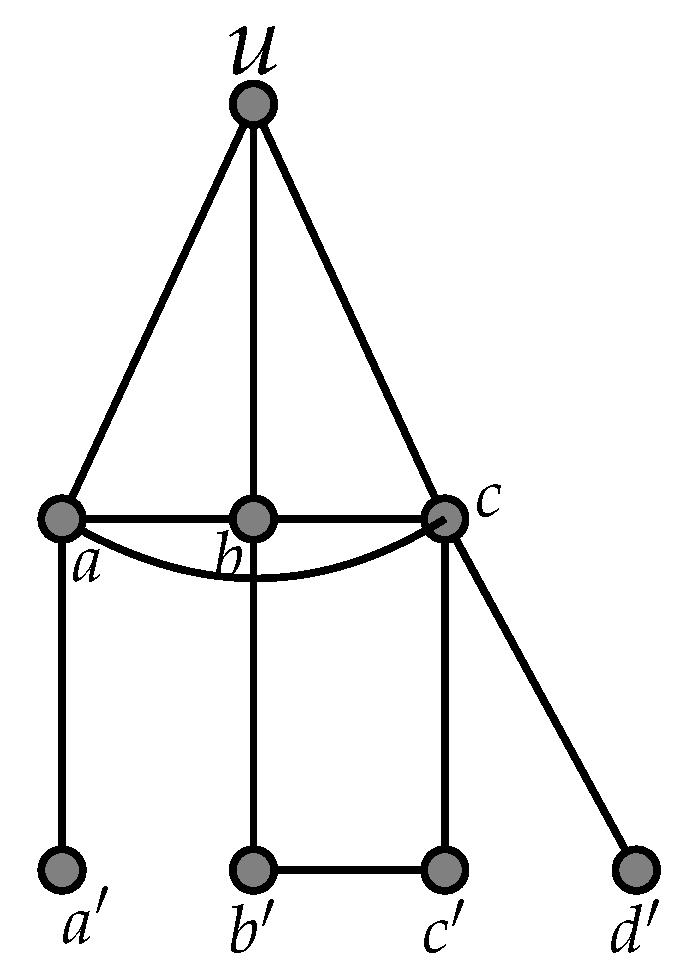
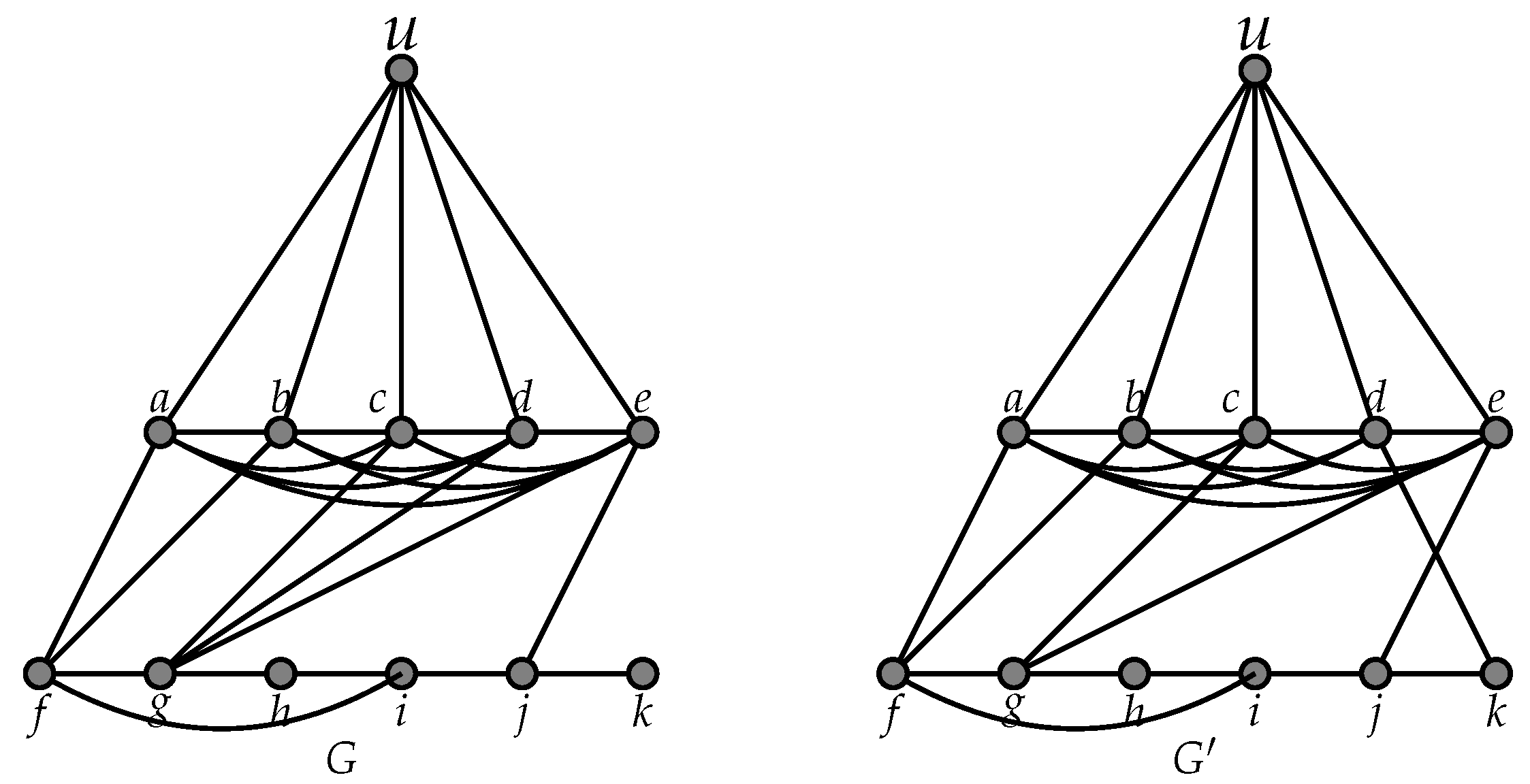
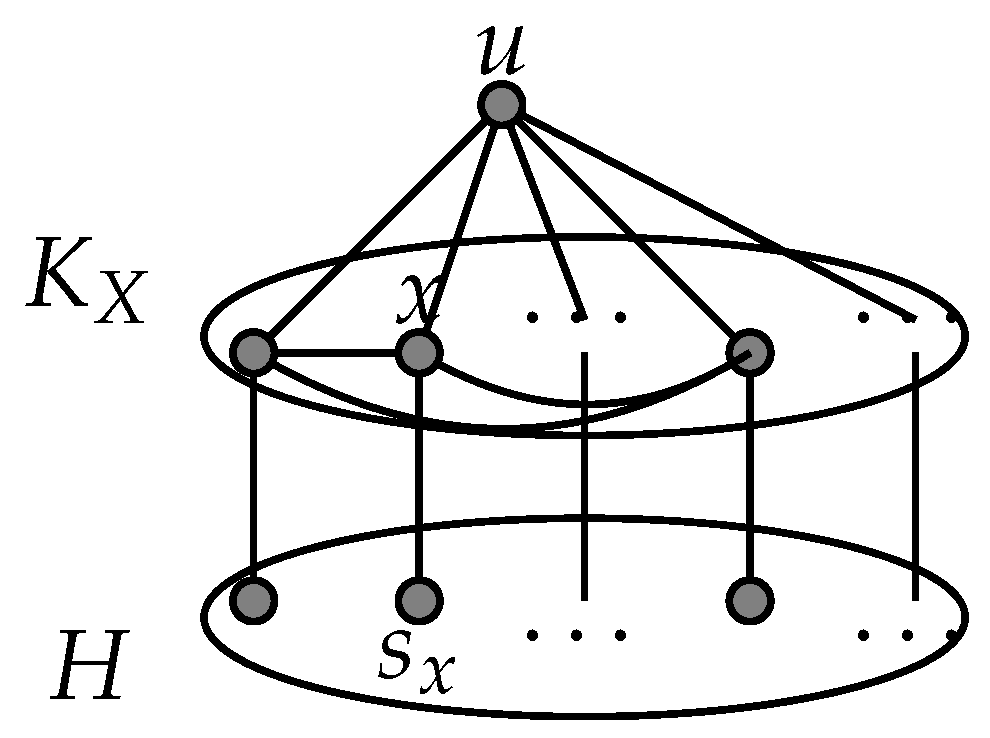
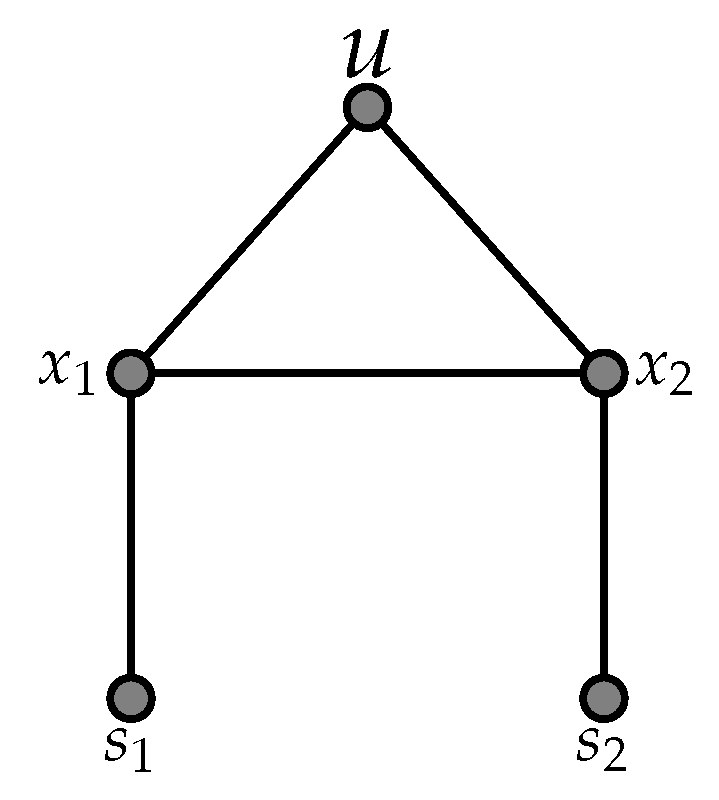
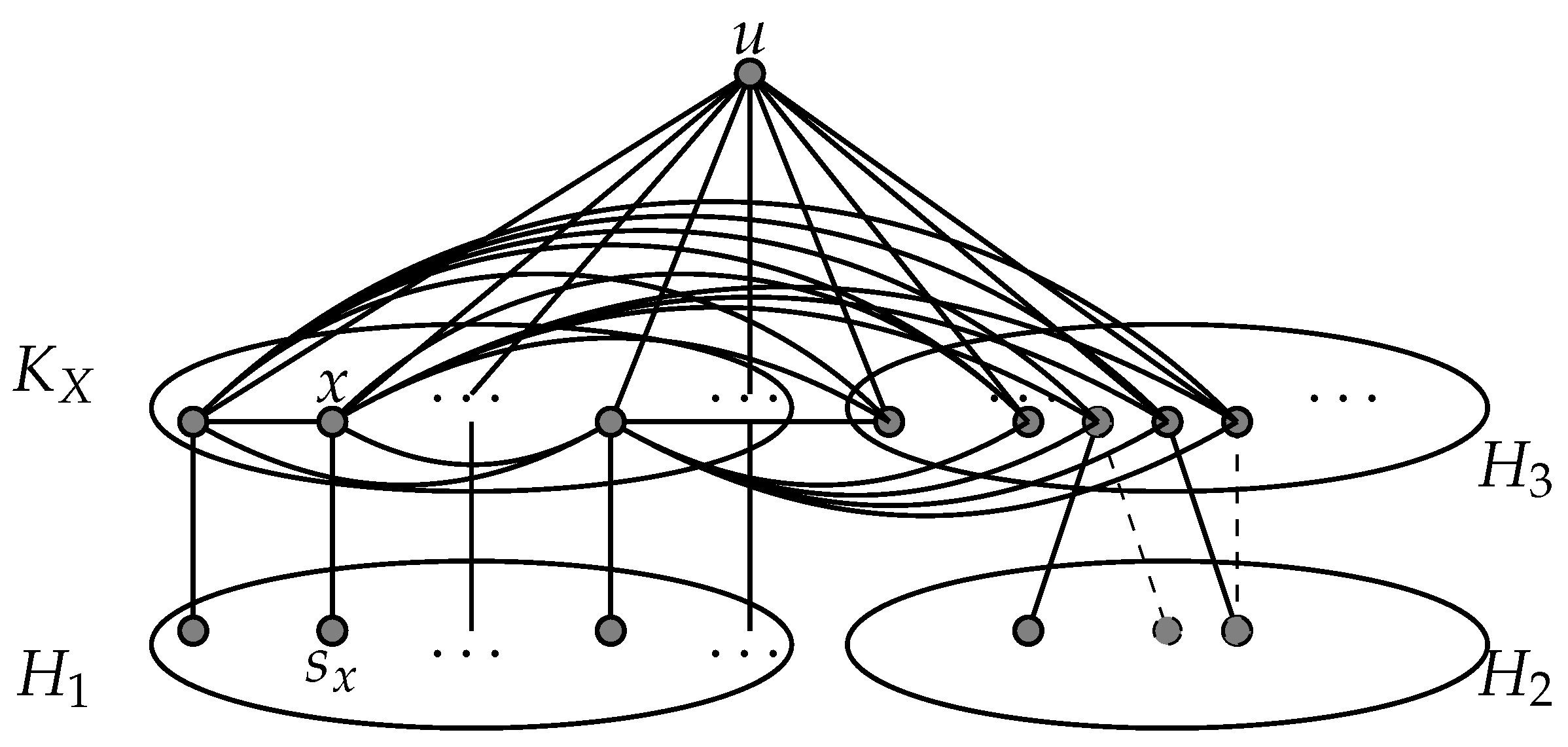

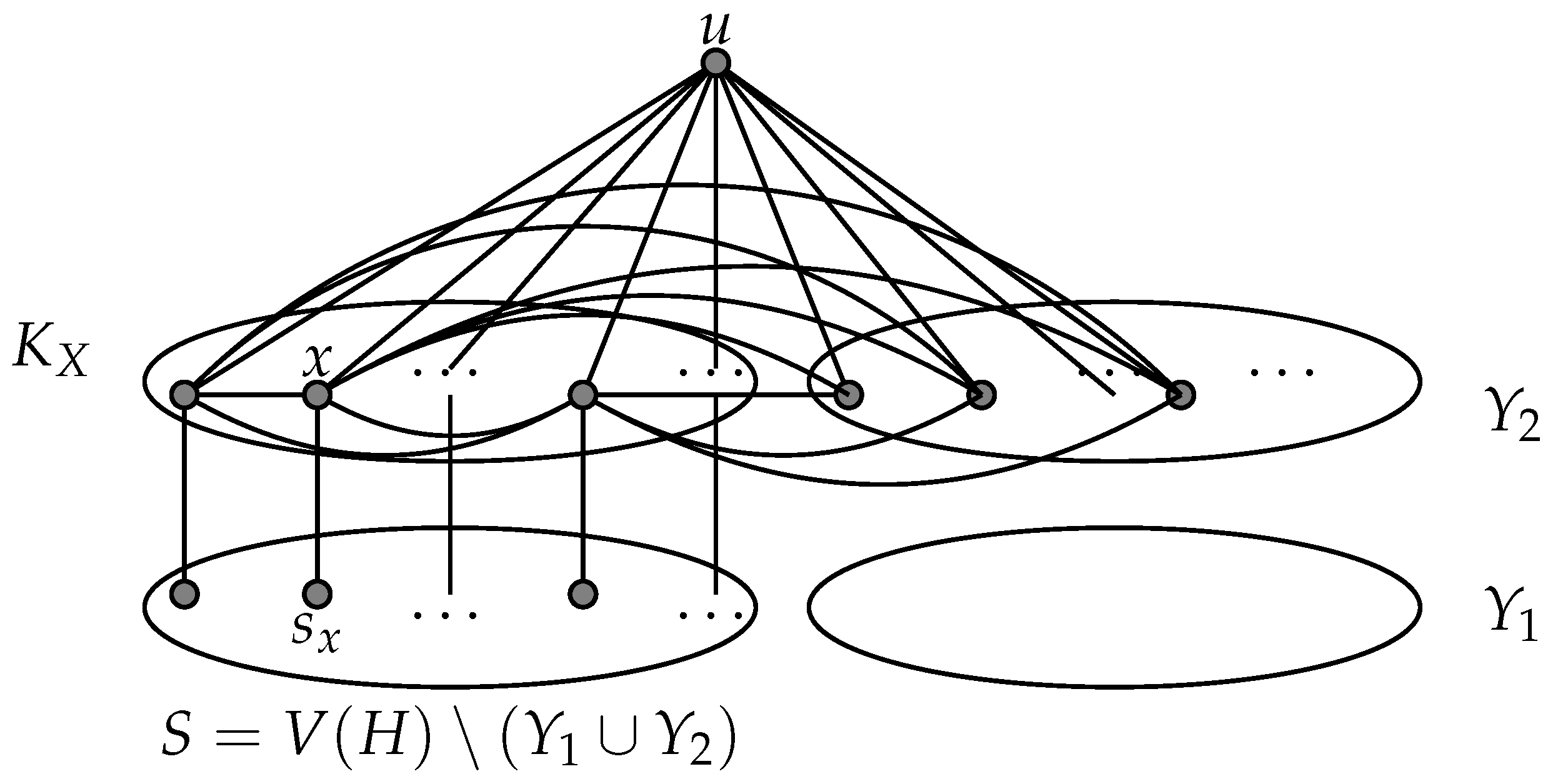
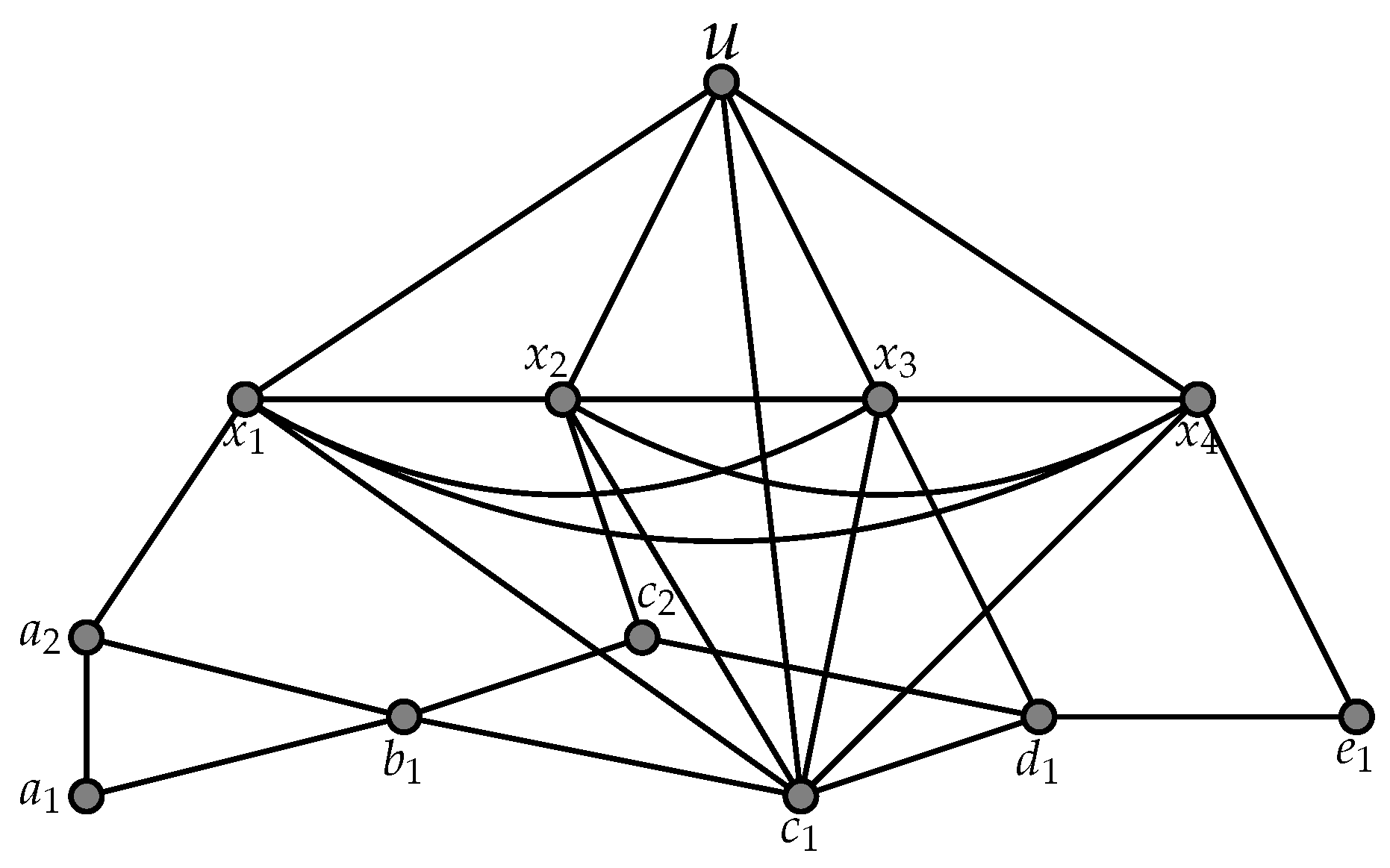
Disclaimer/Publisher’s Note: The statements, opinions and data contained in all publications are solely those of the individual author(s) and contributor(s) and not of MDPI and/or the editor(s). MDPI and/or the editor(s) disclaim responsibility for any injury to people or property resulting from any ideas, methods, instructions or products referred to in the content. |
© 2025 by the authors. Licensee MDPI, Basel, Switzerland. This article is an open access article distributed under the terms and conditions of the Creative Commons Attribution (CC BY) license (https://creativecommons.org/licenses/by/4.0/).
Share and Cite
Ben Amira, A.; Bouaziz, M. Prime Graphs with Almost True Twin Vertices. Mathematics 2025, 13, 3466. https://doi.org/10.3390/math13213466
Ben Amira A, Bouaziz M. Prime Graphs with Almost True Twin Vertices. Mathematics. 2025; 13(21):3466. https://doi.org/10.3390/math13213466
Chicago/Turabian StyleBen Amira, Aymen, and Moncef Bouaziz. 2025. "Prime Graphs with Almost True Twin Vertices" Mathematics 13, no. 21: 3466. https://doi.org/10.3390/math13213466
APA StyleBen Amira, A., & Bouaziz, M. (2025). Prime Graphs with Almost True Twin Vertices. Mathematics, 13(21), 3466. https://doi.org/10.3390/math13213466





